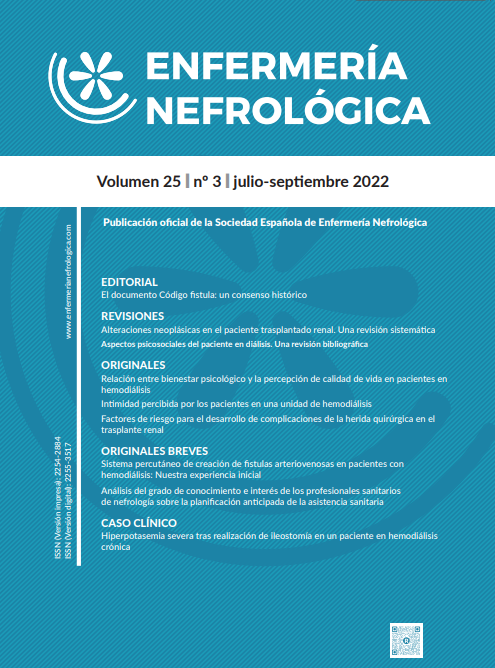Contenido del artículo principal
Resumen
El documento “Código fistula” ha sido elaborado por el Grupo Español Multidisciplinar del Acceso Vascular (GEMAV) en colaboración con las asociaciones españolas de pacientes renales ALCER y ADER. A imagen y semejanza de “Código infarto” y “Código ictus”, el “Código fístula” pretende ser un protocolo de atención urgente que permite identificar a las personas con enfermedad renal tratadas mediante hemodiálisis que presentan una patología aguda de su acceso vascular arteriovenoso, es decir, fístula nativa y fístula protésica, para trasladarlas, lo más rápidamente posible, a la Unidad Funcional del Acceso Vascular o al Hospital de referencia y efectuar el tratamiento mediante cirugía o procedimiento endovascular. Como la trombosis es la complicación más frecuente de la fístula, este evento será la causa más frecuente de activación del “Código fístula”. Dado que la trombosis incrementa la incidencia de hospitalización, el gasto sanitario y la morbimortalidad de la persona con enfermedad renal, el rescate de toda fístula trombosada debería ser una prioridad absoluta y considerarse una patología de manejo preferente que precisa de una solución lo más rápida posible. El documento “Código fistula”, además de GEMAV, ALCER y ADER, se ha consensuado por los siguientes grupos de trabajo y Sociedades Científicas españolas vinculadas a la atención de las persones con enfermedad renal (por orden alfabético): GEIRAS, SEACV, SEDEN, SEDYT, S.E.N. y SERVEI. Esperemos que pronto pueda aplicarse en todo el territorio español.
Palabras clave
Detalles del artículo

Esta obra está bajo una licencia internacional Creative Commons Atribución-NoComercial 4.0.
Aviso de derechos de autor/a
© Los autores ceden de forma no exclusiva los derechos de explotación de los trabajos publicados y consiente en que su uso y distribución se realice con la Licencia Creative Commons Atribución - No comercial 4.0 Internacional (CC BY-NC 4.0). Puede consultar desde aquí la versión informativa y el texto legal de la licencia. Esta circunstancia ha de hacerse constar expresamente de esta forma cuando sea necesario.
Referencias
- Bienvenida del Presidente. Grupo Español Multidiscipli-nar del Acceso Vascular (GEMAV) [consultado 1 Jul 2022]. Disponible en: www.gemav.org.
- Boenink R, Stel VS, Waldum-Grevbo BE, Collart F, Kersch-baum J, Heaf JG, et al. Data from the ERA-EDTA Registry were examined for trends in excess mortality in European adults on kidney replacement therapy. Kidney Int 2020; 98(4):999-1008. DOI: https://doi.org/10.1016/j.kint.2020.05.039
- Roca-Tey R. Diagnóstico precoz de la estenosis del acceso vascular para hemodiálisis mediante la determinación no invasiva del flujo sanguíneo. Tesis Doctoral. Universitat Autónoma de Barcelona, 2010. Disponible en: http://hdl.handle.net/10803/32023.
- Ibeas J, Roca-Tey R, Vallespín J, Moreno T, Moñux G, Mar-tí-Monrós A, et al. Guía española del acceso vascular para hemodiálisis. Nefrologia 2017;37(Supl 1):S1–191. DOI: https://doi.org/10.1016/j.nefro.2017.11.004
- Girerd S, Girerd N, Frimat L, Holdaas H, Jardine AG, Sch-mieder RE, et al. Arteriovenous fistula thrombosis I asso-ciated with increased all-cause and cardiovascular mor-tality in haemodialysis patients from the AURORA trial. Clinical Kidney Journal 2020;13(1):116–22. DOI: https://doi.org/10.1093/ckj/sfz048
- Roca-Tey R, Ibeas J, Moreno T, Gruss E, Merino JL, Va-llespín J, et al. Behalf of the Spanish Multidisciplinary Vascular Access Group (GEMAV). Dialysis arteriovenous access monitoring and surveillance according to the 2017 Spanish guidelines. J Vasc Access 2018;19(5):422-9. DOI: https://doi.org/10.1177/1129729818761307
- Saha M, Allon M. Diagnosis, Treatment, and Prevention of Hemodialysis Emergencies. Clin J Am Soc Nephrol 2017;12:357-69. DOI: https://doi.org/10.2215/CJN.05260516
- Blake PG , Quinn RR, Oliver MJ. The risks of vascular Ac-cess. Kidney Int 2012;82:623-5. DOI: https://doi.org/10.1038/ki.2012.181
- Ellingson KD, Palekar RS, Lucero CA, Kurkjian KM, Chai SJ, Schlossberg DS, et al. Vascular access hemorrhages con-tribute to deaths among hemodialysis patients. Kidney Int 2012;82(6):686-92.Artículo en Acceso Abierto, se distribuye bajo una Licencia Creative Commons Atribución-NoComercial 4.0 Internacional.https://creativecommons.org/licenses/by-nc/4.0/. DOI: https://doi.org/10.1038/ki.2012.185
Referencias
Bienvenida del Presidente. Grupo Español Multidiscipli-nar del Acceso Vascular (GEMAV) [consultado 1 Jul 2022]. Disponible en: www.gemav.org.
Boenink R, Stel VS, Waldum-Grevbo BE, Collart F, Kersch-baum J, Heaf JG, et al. Data from the ERA-EDTA Registry were examined for trends in excess mortality in European adults on kidney replacement therapy. Kidney Int 2020; 98(4):999-1008. DOI: https://doi.org/10.1016/j.kint.2020.05.039
Roca-Tey R. Diagnóstico precoz de la estenosis del acceso vascular para hemodiálisis mediante la determinación no invasiva del flujo sanguíneo. Tesis Doctoral. Universitat Autónoma de Barcelona, 2010. Disponible en: http://hdl.handle.net/10803/32023.
Ibeas J, Roca-Tey R, Vallespín J, Moreno T, Moñux G, Mar-tí-Monrós A, et al. Guía española del acceso vascular para hemodiálisis. Nefrologia 2017;37(Supl 1):S1–191. DOI: https://doi.org/10.1016/j.nefro.2017.11.004
Girerd S, Girerd N, Frimat L, Holdaas H, Jardine AG, Sch-mieder RE, et al. Arteriovenous fistula thrombosis I asso-ciated with increased all-cause and cardiovascular mor-tality in haemodialysis patients from the AURORA trial. Clinical Kidney Journal 2020;13(1):116–22. DOI: https://doi.org/10.1093/ckj/sfz048
Roca-Tey R, Ibeas J, Moreno T, Gruss E, Merino JL, Va-llespín J, et al. Behalf of the Spanish Multidisciplinary Vascular Access Group (GEMAV). Dialysis arteriovenous access monitoring and surveillance according to the 2017 Spanish guidelines. J Vasc Access 2018;19(5):422-9. DOI: https://doi.org/10.1177/1129729818761307
Saha M, Allon M. Diagnosis, Treatment, and Prevention of Hemodialysis Emergencies. Clin J Am Soc Nephrol 2017;12:357-69. DOI: https://doi.org/10.2215/CJN.05260516
Blake PG , Quinn RR, Oliver MJ. The risks of vascular Ac-cess. Kidney Int 2012;82:623-5. DOI: https://doi.org/10.1038/ki.2012.181
Ellingson KD, Palekar RS, Lucero CA, Kurkjian KM, Chai SJ, Schlossberg DS, et al. Vascular access hemorrhages con-tribute to deaths among hemodialysis patients. Kidney Int 2012;82(6):686-92.Artículo en Acceso Abierto, se distribuye bajo una Licencia Creative Commons Atribución-NoComercial 4.0 Internacional.https://creativecommons.org/licenses/by-nc/4.0/. DOI: https://doi.org/10.1038/ki.2012.185




